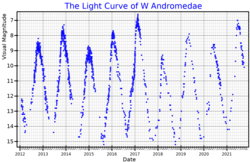| Observation data Epoch J2000 Equinox J2000 | |
|---|---|
| Constellation | Andromeda |
| Right ascension | 02h 17m 32.96122s[2] |
| Declination | +44° 18′ 17.7573″[2] |
| Apparent magnitude (V) | 6.7 – 14.6[3] |
| Characteristics | |
| Spectral type | S6,1e-S9,2e[3] |
| Variable type | Mira[3] |
| Astrometry | |
| Radial velocity (Rv) | −38.19±0.4[4] km/s |
| Proper motion (μ) | RA: −0.162[2] mas/yr Dec.: −2.516[2] mas/yr |
| Parallax (π) | 2.2125 ± 0.0953 mas[2] |
| Distance | 1,470 ± 60 ly (450 ± 20 pc) |
| Absolute magnitude (MV) | −5.27[5] |
| Details | |
| Mass | 5.6[6] M☉ |
| Luminosity | 8,394[7] L☉ |
| Surface gravity (log g) | −0.61[6] cgs |
| Temperature | 3,030[6] K |
| Metallicity [Fe/H] | 0.003[6] dex |
| Other designations | |
| Database references | |
| SIMBAD | data |
W Andromedae is a variable star in the constellation of Andromeda. It is classified as a Mira variable and S-type star,[8] and varies from an apparent visual magnitude of 14.6 at minimum brightness to a magnitude of 6.7 at maximum brightness, with a period of approximately 397.3 days.[3] The star is losing mass due to stellar winds at a rate of 2.79×10−7 M☉/yr.[5]
References
- ^ "Download Data". aavso.org. AAVSO. Retrieved 1 October 2021.
- ^ a b c d e Brown, A. G. A.; et al. (Gaia collaboration) (2021). "Gaia Early Data Release 3: Summary of the contents and survey properties". Astronomy & Astrophysics. 649: A1. arXiv:2012.01533. Bibcode:2021A&A...649A...1G. doi:10.1051/0004-6361/202039657. S2CID 227254300. (Erratum: doi:10.1051/0004-6361/202039657e). Gaia EDR3 record for this source at VizieR.
- ^ a b c d Samus, N. N.; Durlevich, O. V.; et al. (2009). "VizieR Online Data Catalog: General Catalogue of Variable Stars (Samus+ 2007-2013)". VizieR On-line Data Catalog: B/GCVS. Originally Published in: 2009yCat....102025S. 1: B/gcvs. Bibcode:2009yCat....102025S.
- ^ Famaey, B.; Jorissen, A.; Luri, X.; Mayor, M.; Udry, S.; Dejonghe, H.; Turon, C. (December 2005). "Local kinematics of K and M giants from CORAVEL/Hipparcos/Tycho-2 data. Revisiting the concept of superclusters". Astronomy and Astrophysics. 340: 165–186. arXiv:astro-ph/0409579. Bibcode:2005A&A...430..165F. doi:10.1051/0004-6361:20041272.
- ^ a b Guandalini, R. (April 2010). "Infrared photometry and evolution of mass-losing AGB stars. III. Mass loss rates of MS and S stars". Astronomy and Astrophysics. 513: A4. arXiv:1002.2458. Bibcode:2010A&A...513A...4G. doi:10.1051/0004-6361/200911764. S2CID 119193286.
- ^ a b c d Anders, F.; Khalatyan, A.; Queiroz, A. B. A.; Chiappini, C.; Ardevol, J.; Casamiquela, L.; Figueras, F.; Jimenez-Arranz, O.; Jordi, C.; Monguio, M.; Romero-Gomez, M.; Altamirano, D.; Antoja, T.; Assaad, R.; Cantat-Gaudin, T.; Castro-Ginard, A.; Enke, H.; Girardi, L.; Guiglion, G.; Khan, S.; Luri, X.; Miglio, A.; Minchev, I.; Ramos, P.; Santiago, B. X.; Steinmetz, M. (2022). "VizieR Online Data Catalog: StarHorse2, Gaia EDR3 photo-astrometric distances (Anders+, 2022)". Vizier Online Data Catalog. Bibcode:2022yCat.1354....0A.
- ^ McDonald, I.; Zijlstra, A. A.; Boyer, M. L. (21 November 2012). "Fundamental parameters and infrared excesses of Hipparcos stars: Parameters and IR excesses from Hipparcos". Monthly Notices of the Royal Astronomical Society. 427 (1): 343–357. arXiv:1208.2037. Bibcode:2012MNRAS.427..343M. doi:10.1111/j.1365-2966.2012.21873.x. eISSN 1365-2966. ISSN 0035-8711.
- ^ "W And". International Variable Star Index. AAVSO. Retrieved 2023-04-22.

